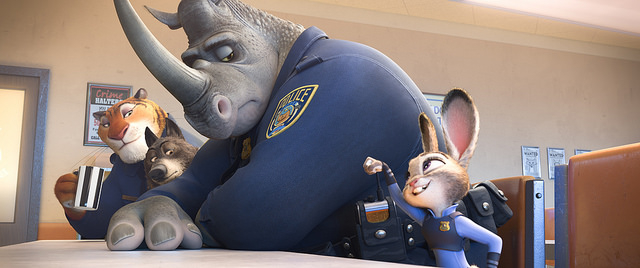Why “Zootopia” is the Societal Critique Americans Need to See

image: “Zootopia” by Ma_Co2013 via Flickr / C.C by 2.0.
Disney’s last 3-D animated feature “Zootopia” presents a world of inequality masquerading as a utopia where “anyone can be anything.”
The movie quickly shows that this ideal is not true. As a child, the protagonist Judy shares that she wants to be a police officer. She is told to give up on her dreams and to instead become a carrot farmer like all the other bunnies.
These exclusions are not just in the police department; as a child, Nick is not allowed in the “Junior Ranger Scouts” due to being a fox. In short, the different animals have their own designated places despite the initial belief in universal opportunity, similar to the disillusioned “American Dream.”
Mirroring the human world, these barriers are not in place because certain species do not have the proper qualifications. Instead, different people are left out of positions because the systems do not accommodate them, and sometimes actively try to exclude them. For example, in police training, the facilities are all too big for Judy. From the obstacles on the training course to the toilets, nothing is made for anyone her size. That was why no other bunny had made it as an officer before: the system itself was not made for them.
However, Judy never quits. She finds ways around the obstacles presented for her, not by trying to be like a different animal, but with her natural talents. She uses her agility, hearing, and jumping ability to her advantage, and ultimately graduates at the top of her class. Her achievements send an important message: do not try to fit the mold of the oppressor, but to use your own power and abilities to your advantage.
In Zootopia, society is divided into two classes: prey and predators. The prey is the majority class, and they unite against the predators as their “common enemy”. Although there is sharp division between the animals, the film illustrates that social inequality is not one-dimensional. Specifically, “Zootopia” shows that even those belonging to the usually opressed prey class can be privileged. For instance, Assistant Mayor Bellwether belongs to the prey class, and is an overlooked member within the class. Despite being Assistant Mayor she is treated as nothing more than a glorified secretary. Using fear mongering tactics though, she turns the prey population against the predators and succeeds former Mayor Lionheart as the new mayor.
More broadly, the movie serves as an allegory for navigating the maze of privilege in the real world and for understanding privilege in relative rather than absolute terms. Judy is disadvantaged as a rabbit, but still fares better than Nick (a predator) in some aspects. For example, Judy is not mistrusted on the basis of her race, but Nick is denied service at restaurants because he is a fox.
Ultimately, the film condemns numerous stereotypes. Some stereotypes are dangerous, and are shown to have a detrimental role in fear mongering. For example, the belief that predators are innately dangerous is internalized in the public mind so thoroughly that when any evidence is presented, prey readily accept it and subsequently unite against predators.
In addition, the film conveys that even seemingly harmless stereotypes can be damaging. This is highlighted in a moment between Judy and Officer Clawhauser. Clawhauser calls Judy “a cute bunny” and Judy corrects him by saying that it’s okay for “other bunnies” to call a bunny “cute,” but it is not okay for other animals to do so. Clawhauser immediately recognizes his mistake and admits to being frustrated by being pigeonholed into the stereotype of being just a donut-loving, fat cheetah himself.
While art is transformative, it by no means provides absolute salvation. “Zootopia” is not the solution to these problems, but it could be the start of a dialogue about cultural awareness. As Judy states at the closing of the film, “change starts with all of us.”
Kerri Yund contributed to this article.




